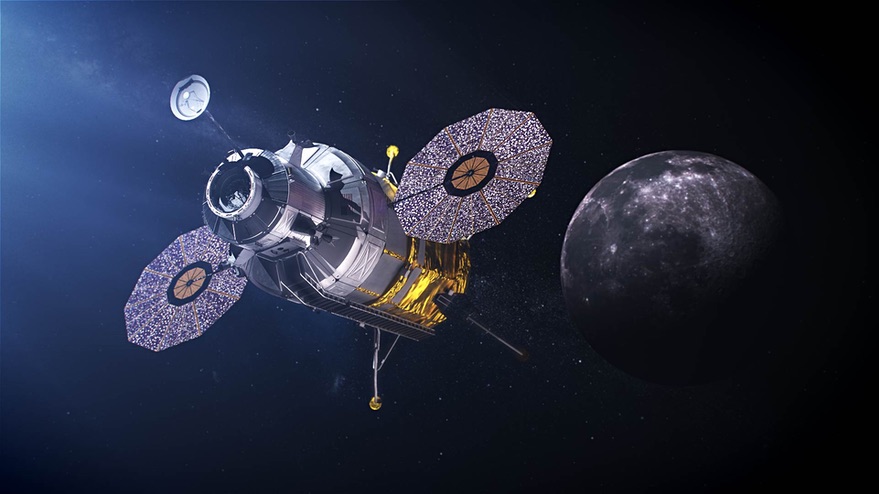
WASHINGTON — A revised plan for returning astronauts to the surface of the moon by 2024 will no longer rely on the use of a lunar Gateway, although NASA’s human spaceflight head says the agency is still committed to eventually developing it.
In a conversation with the NASA Advisory Council’s science committee March 13, Doug Loverro, NASA associate administrator for human exploration and operations, said he had been working to “de-risk” the Artemis program to focus primarily on the mandatory activities needed to achieve the 2024 landing goal.
He noted that, in the Apollo program, it took the lunar lander program six and a half years to go from contract signing to the Apollo 11 landing. By contrast, NASA has less than five years before the current deadline. “What are we going to do to go ahead and make that happen? And the answer is you’ve got to go ahead and remove all the things that add to program risk along the way,” he said.
That includes, he said, technology development and activities that have not been done in space before. He also said that risk that can’t be eliminated should be “burned down” as early as possible. “What are all of the risks that can get in our way in a four-and-a-half-year schedule and how do we go ahead and pull them all early into program, or eliminate them from the program altogether by going ahead and making wise technical or programmatic choices?” he said.
Later in the half-hour session, he said that means taking the lunar Gateway off the critical path for the 2024 landing. That was in part because of what he deemed a “high possibility” of it falling behind schedule since it will use high-power solar electric propulsion in its first module, the Power and Propulsion Element.
“From a physics perspective, I can guarantee you we do not need it for this launch,” he said of the Gateway.
He emphasized, though, that NASA was not abandoning the lunar Gateway. “By taking Gateway out of the critical path for the lunar landing in ’24, I believe what we have done is create a far better Gateway program,” he said. NASA’s international partners, which had planned to develop modules or other capabilities for it, will be formally informed of NASA’s plans on March 16, but Loverro believes that should not be an issue for them since they weren’t planning to have their contributions ready before 2026. That Gateway will still be needed for later, “sustainable” lunar exploration missions.
“We can now tell them 100% positively it will be there because we’ve changed that program to a much more what I would call solid, accomplishable schedule,” he said. He added there were unspecified changes to the Gateway design to reduce its cost “so I don’t get into a struggle” between the cost of the Gateway and human lunar landers, suggesting there were cost overruns with the Gateway.
“Frankly, had we not done that simplification, I was going to have to cancel Gateway because I couldn’t afford it,” he said. “By simplifying it and taking it out of the critical path, I can now keep it on track.”
Loverro also hinted that NASA was modifying its approach to lunar lander development. NASA previously proposed a three-stage approach, with an ascent module, descent module, and transfer module all launched separately on commercial launch vehicles and assembled at the lunar Gateway. Companies, though, were free to propose alternative approaches, such as fully integrated landers, in the ongoing Human Landing System competition.
“Program risk is driven by which things haven’t you done in space before that you would now have to do in this mission,” he said, referring to plans “to launch a lander in three individual pieces that have to meet up at the moon,” the approach NASA has previously discussed. “We’ve never done that before, so we’d like to try to avoid doing things we’ve never done before.”
The revised Artemis plan is not yet finalized, he said. “We will obviously roll out that plan when we have it all locked into stone in the budget, in policy,” he said. He didn’t give a timetable for doing so other than the “near future.”
Some in industry expect announcements could be tied to the next meeting of the National Space Council, which the White House said March 13 was still scheduled for March 24 despite the growing effects of the coronavirus pandemic. That meeting, which had been scheduled for the Glenn Research Center in Cleveland, will now take place at the Eisenhower Executive Office Building in Washington.
The coronavirus pandemic is an additional complication for NASA’s exploration plans, Loverro said, describing it as one of several failure modes, along with technical, budget and policy concerns, for Artemis. He said there had been discussions of doing “temperature checks” of workers at the Stennis Space Center in Mississippi where the SLS core stage is being tested, “to make sure we don’t have the entire workforce down for a month.”
“How do you deal with the unexpected? We’re going to have unexpected things happen,” he said. “We have to plan for failures along all those lines and figure out how we either mitigate them by action beforehand or working to mitigate them by action we take later.”
Bagikan Berita Ini














0 Response to "NASA takes Gateway off the critical path for 2024 lunar return - SpaceNews"
Post a Comment